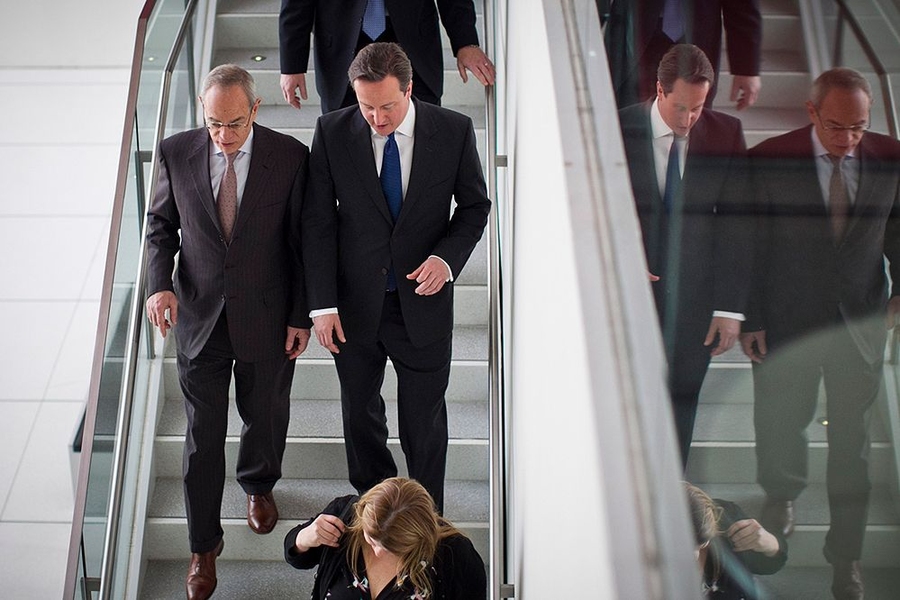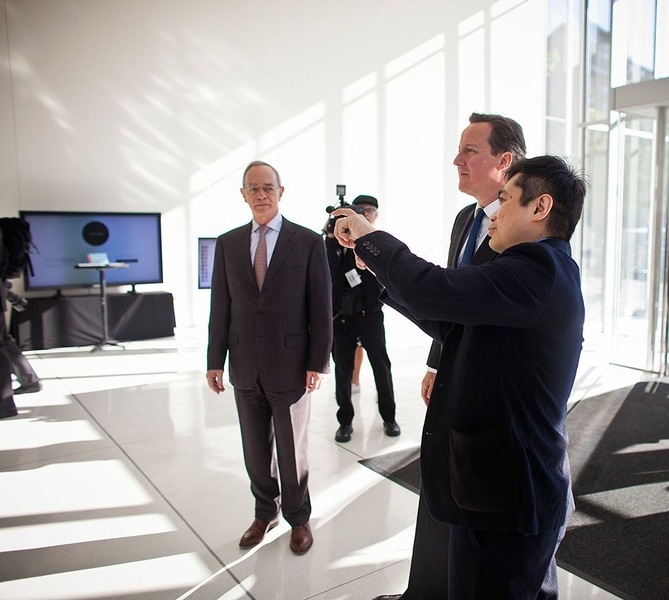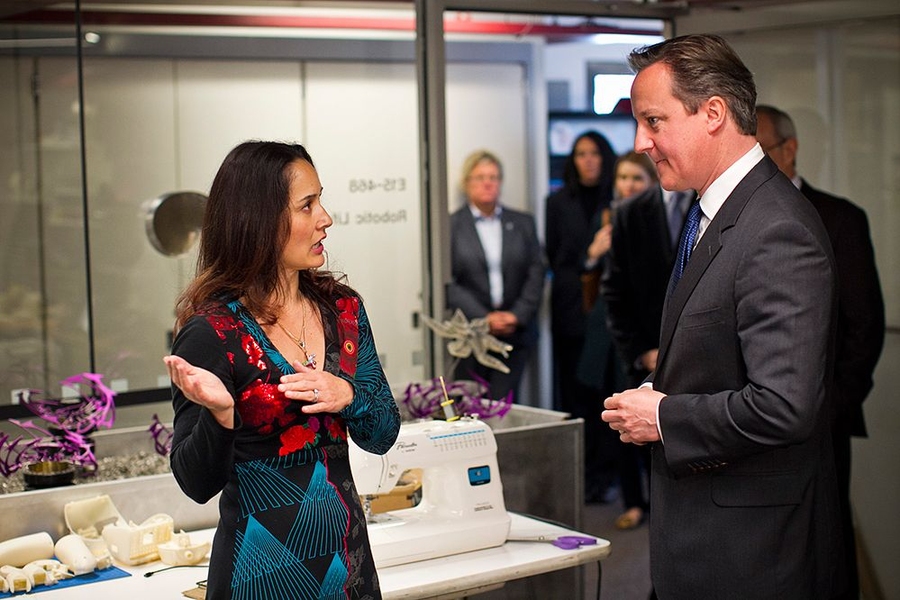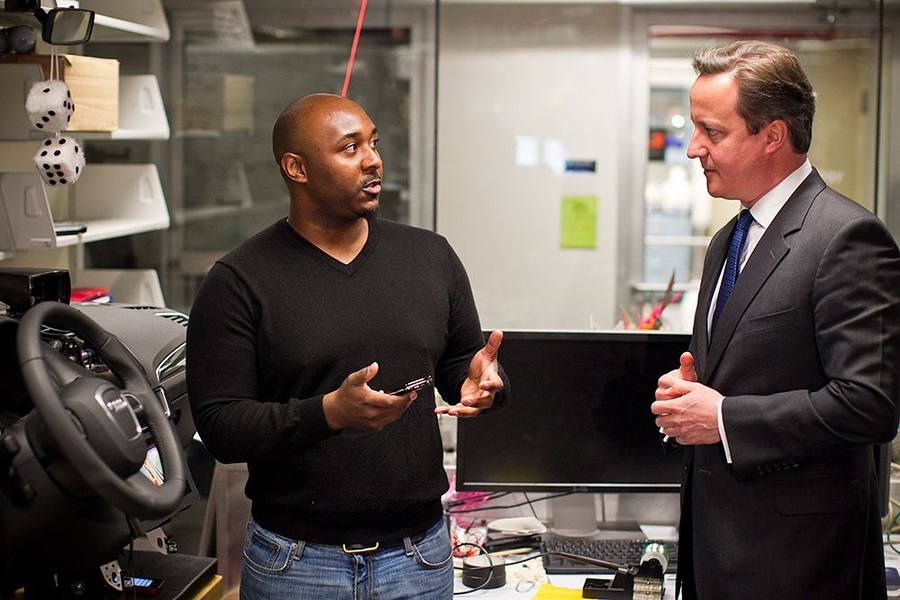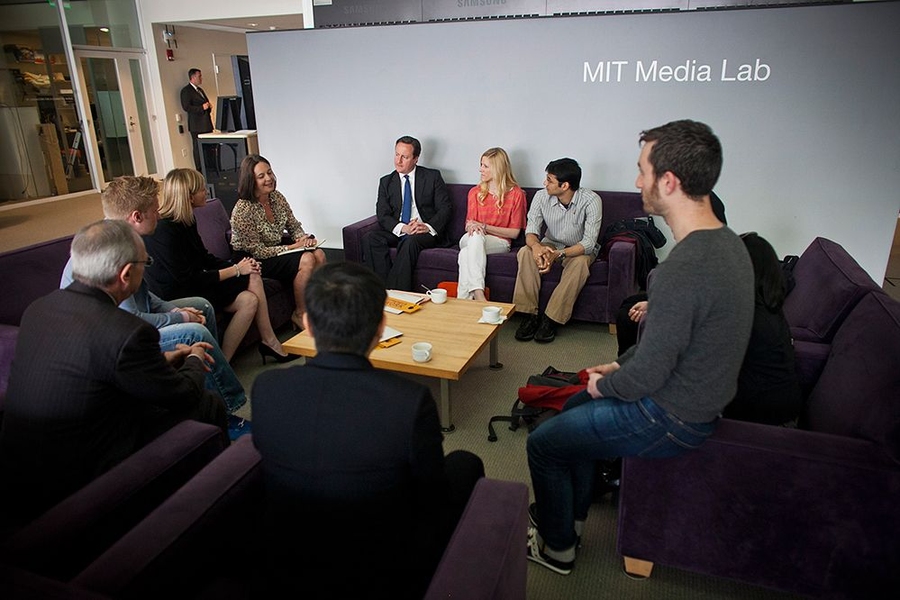In a 90-minute visit to the MIT campus today, British Prime Minister David Cameron met with President L. Rafael Reif and Media Lab director Joichi Ito, faculty members and students, and a group of young MIT entrepreneurs.
During his visit — which was not publicized in advance due to security concerns — Cameron was presented with a framed set of photos commemorating a collaboration between MIT and the British government during World War II. That effort developed microwave radar systems that could be carried aboard airplanes, providing a key advantage to the Allies in winning the war.
In a brief tour of the Media Lab, Cameron met with associate professor of media arts and sciences Cynthia Breazeal, who demonstrated some of her group’s recent robotic creations, which are designed to respond to humans’ emotions.
He also met with Hugh Herr, an associate professor of media arts and sciences and of health sciences and technology, who works on advanced prostheses for amputees. Herr demonstrated some of the new devices under development in his lab — including the advanced foot-and-ankle prosthetics that Herr, a double amputee, uses himself.
Cameron met informally with a small group of students and recent alumni who have started businesses, or are in the process of doing so. The seven young entrepreneurs each gave a brief introduction to their inventions or concepts for a startup; Cameron then asked questions about their projects.
Fiona Murray, the Skolkovo Foundation Associate Professor of Entrepreneurship at the MIT Sloan School of Management, led that session. Murray, a British citizen, told Cameron, “It’s really the students who are the star of the show.” After the prime minister’s visit, she added, “He did seem impressed, and he seemed to be enjoying himself.”
Murray said the young entrepreneurs who Cameron met “represent the diversity of students here on campus,” coming from different departments yet often engaging in interdisciplinary projects.
“I think he was trying to get at what makes entrepreneurship part of the ecosystem here,” said MIT Sloan graduate student Bridget Akinc, who was part of that group. “Is it the academics? [He was] trying to really get at the idea of, can you take a university environment and create more of a culture around entrepreneurship? He asked, ‘Does everybody come here with a business idea, knowing that’s what you want to do? Or do you create it while you’re here?’ And there was a combination of responses that really covered the gamut.”
“We all came [to MIT] wanting to do something with impact,” Akinc added, “and entrepreneurship seems to be a vehicle for a lot of the teams that have come out of MIT.”
Elliot Cohen, an MBA student at MIT Sloan, said, “I really appreciated it, and I appreciated his questions. I think it’s very difficult, if you’re not inside an ecosystem like this, to appreciate the subtle interactions that make up the foundation of it and are so important. The fact that he really spent some time getting to know people like us who are right in the middle of it, to me, is really encouraging. He’s not just trying to analyze it from the outside.”
Akshar Wunnava, a senior majoring in chemical engineering, said, “It was a pretty cool experience, especially to be an undergraduate and to share how my experience here at MIT has shaped what I’ve learned about business.” Wunnava said he is working on a startup to develop bacterial batteries for use in off-grid villages.
After the young entrepreneurs gave Cameron brief descriptions of their business ideas, “He was really sharp, asking us the right questions,” said Danielle Zurovcik SM ’07 PhD ’12, whose startup — which grew out of a class project — aims to develop a device to improve the healing of wounds. Because time was tight, “We actually had to stop him from asking questions, because he was so interested in what we were working on,” she said. “He was genuinely interested in hearing us.”
Zurovcik said Cameron noted that many universities around the world have tried to become centers of innovation and entrepreneurship, but few have done so as successfully as MIT. Cameron, she said, seemed to be very interested in learning, “How does MIT do it successfully?”
During his visit — which was not publicized in advance due to security concerns — Cameron was presented with a framed set of photos commemorating a collaboration between MIT and the British government during World War II. That effort developed microwave radar systems that could be carried aboard airplanes, providing a key advantage to the Allies in winning the war.
He also met with Hugh Herr, an associate professor of media arts and sciences and of health sciences and technology, who works on advanced prostheses for amputees. Herr demonstrated some of the new devices under development in his lab — including the advanced foot-and-ankle prosthetics that Herr, a double amputee, uses himself.
Cameron met informally with a small group of students and recent alumni who have started businesses, or are in the process of doing so. The seven young entrepreneurs each gave a brief introduction to their inventions or concepts for a startup; Cameron then asked questions about their projects.
Fiona Murray, the Skolkovo Foundation Associate Professor of Entrepreneurship at the MIT Sloan School of Management, led that session. Murray, a British citizen, told Cameron, “It’s really the students who are the star of the show.” After the prime minister’s visit, she added, “He did seem impressed, and he seemed to be enjoying himself.”
Murray said the young entrepreneurs who Cameron met “represent the diversity of students here on campus,” coming from different departments yet often engaging in interdisciplinary projects.
“I think he was trying to get at what makes entrepreneurship part of the ecosystem here,” said MIT Sloan graduate student Bridget Akinc, who was part of that group. “Is it the academics? [He was] trying to really get at the idea of, can you take a university environment and create more of a culture around entrepreneurship? He asked, ‘Does everybody come here with a business idea, knowing that’s what you want to do? Or do you create it while you’re here?’ And there was a combination of responses that really covered the gamut.”
“We all came [to MIT] wanting to do something with impact,” Akinc added, “and entrepreneurship seems to be a vehicle for a lot of the teams that have come out of MIT.”
Elliot Cohen, an MBA student at MIT Sloan, said, “I really appreciated it, and I appreciated his questions. I think it’s very difficult, if you’re not inside an ecosystem like this, to appreciate the subtle interactions that make up the foundation of it and are so important. The fact that he really spent some time getting to know people like us who are right in the middle of it, to me, is really encouraging. He’s not just trying to analyze it from the outside.”
Akshar Wunnava, a senior majoring in chemical engineering, said, “It was a pretty cool experience, especially to be an undergraduate and to share how my experience here at MIT has shaped what I’ve learned about business.” Wunnava said he is working on a startup to develop bacterial batteries for use in off-grid villages.
After the young entrepreneurs gave Cameron brief descriptions of their business ideas, “He was really sharp, asking us the right questions,” said Danielle Zurovcik SM ’07 PhD ’12, whose startup — which grew out of a class project — aims to develop a device to improve the healing of wounds. Because time was tight, “We actually had to stop him from asking questions, because he was so interested in what we were working on,” she said. “He was genuinely interested in hearing us.”
Zurovcik said Cameron noted that many universities around the world have tried to become centers of innovation and entrepreneurship, but few have done so as successfully as MIT. Cameron, she said, seemed to be very interested in learning, “How does MIT do it successfully?”
